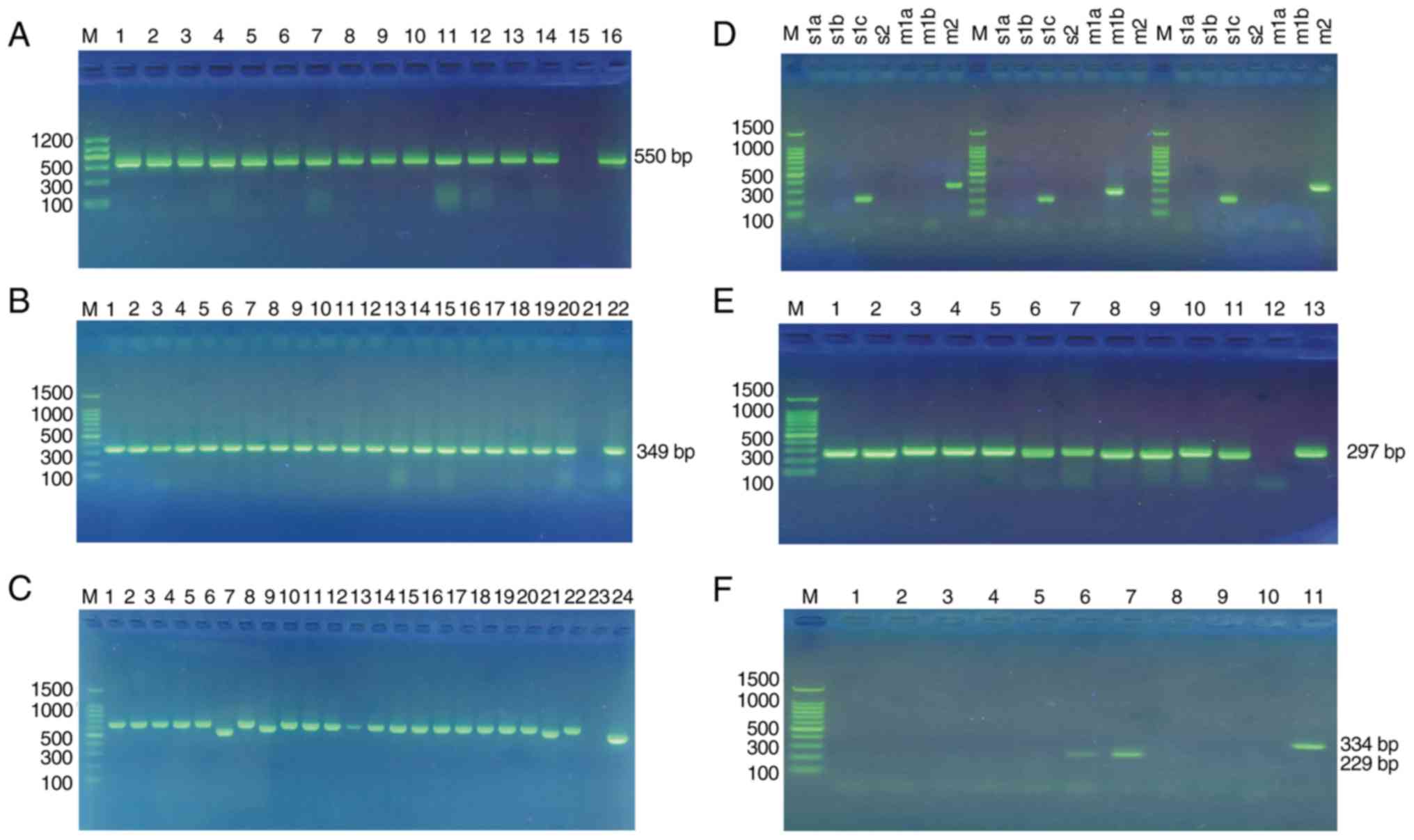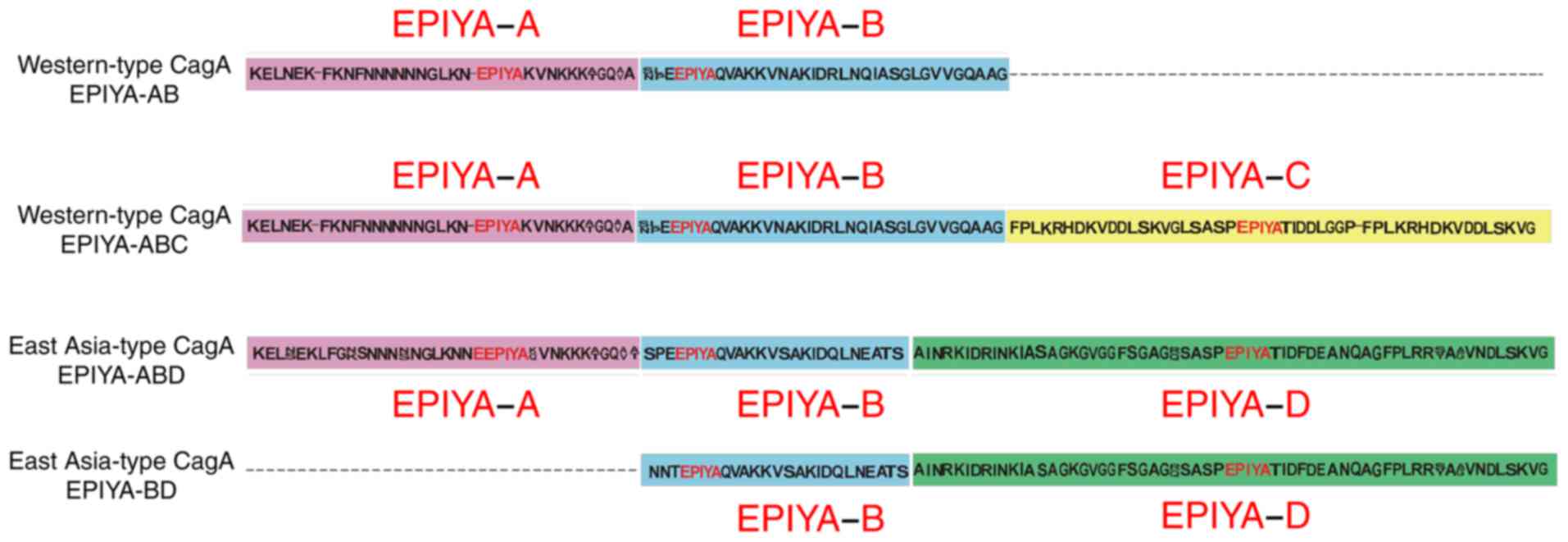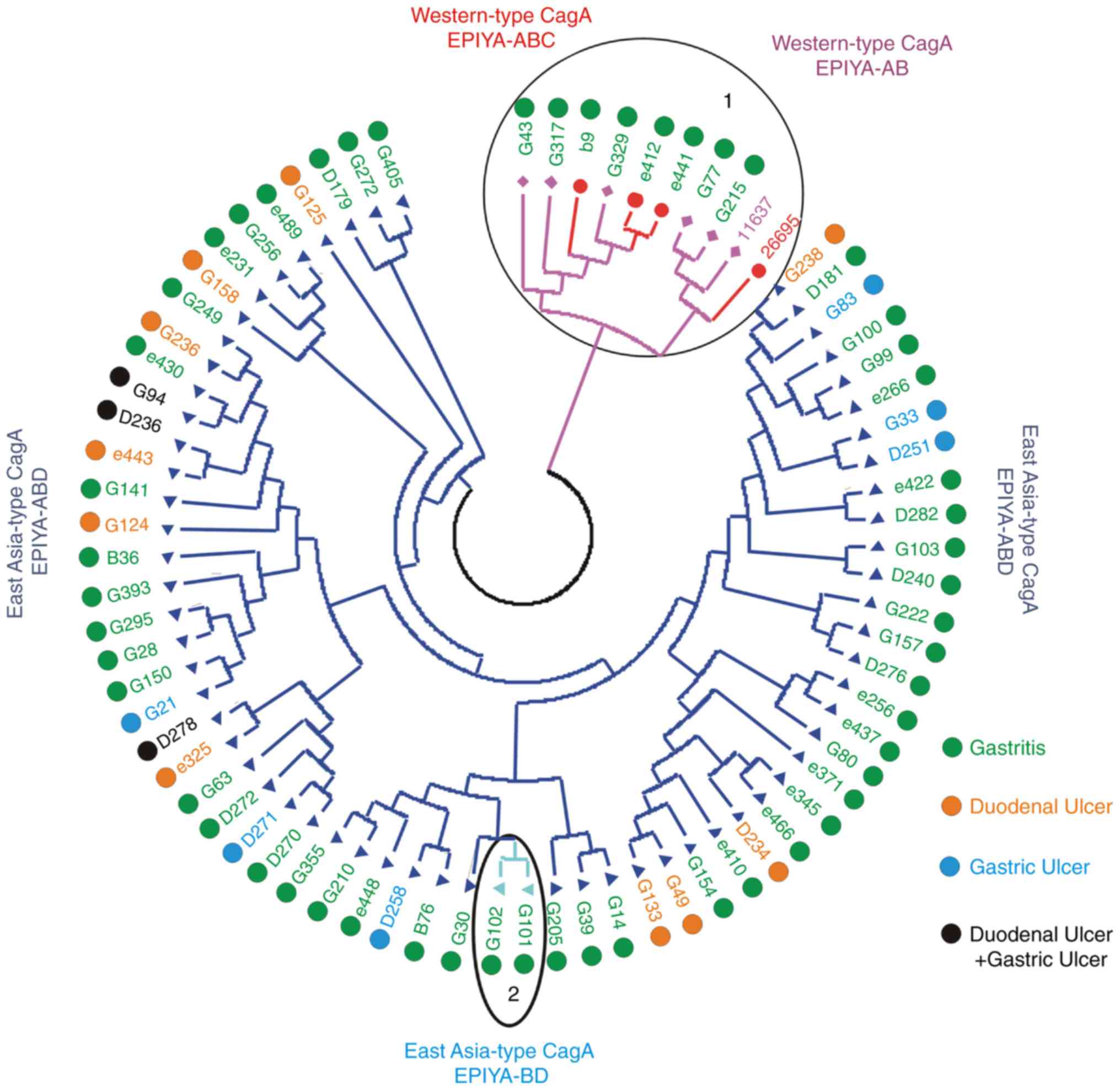|
1
|
Pereira WN, Ferraz MA, Zabaglia LM, de
Labio RW, Orcini WA, Bianchi Ximenez JP, Neto AC, Payão SL and
Rasmussen LT: Association among H. pylori virulence markers dupA,
cagA and vacA in Brazilian patients. J Venom Anim Toxins Incl Trop
Dis. 20:12014. View Article : Google Scholar : PubMed/NCBI
|
|
2
|
Wang HP, Zhu YL and Shao W: Role of
Helicobacter pylori virulence factor cytotoxin-associated gene A in
gastric mucosa-associated lymphoid tissue lymphoma. World J
Gastroenterol. 19:8219–8226. 2013. View Article : Google Scholar : PubMed/NCBI
|
|
3
|
Krisch LM, Posselt G, Hammerl P and
Wessler S: CagA phosphorylation in Helicobacter pylori-infected B
cells is mediated by the non-receptor tyrosine kinases of the Src
and Abl families. Infect Immun. 84:2671–2680. 2016. View Article : Google Scholar : PubMed/NCBI
|
|
4
|
Hashinaga M, Suzuki R, Akada J, Matsumoto
T, Kido Y, Okimoto T, Kodama M, Murakami K and Yamaoka Y:
Differences in amino acid frequency in CagA and VacA sequences of
Helicobacter pylori distinguish gastric cancer from gastric MALT
lymphoma. Gut Pathog. 8:542006. View Article : Google Scholar
|
|
5
|
Zhang M, Zhou YZ, Li XY, Tang Z, Zhu HM,
Yang Y and Chhetri JK: Seroepidemiology of Helicobacter pylori
infection in elderly people in the Beijing region, China. World J
Gastroenterol. 20:3635–3639. 2014. View Article : Google Scholar : PubMed/NCBI
|
|
6
|
Ahn HJ and Lee DS: Helicobacter pylori in
gastric carcinogenesis. World J Gastrointest Oncol. 7:455–465.
2015. View Article : Google Scholar : PubMed/NCBI
|
|
7
|
Datta De D and Roychoudhury S: To be or
not to be: The host genetic factor and beyond in Helicobacter
pylori mediated gastro-duodenal diseases. World J Gastroenterol.
21:2883–2895. 2015. View Article : Google Scholar : PubMed/NCBI
|
|
8
|
Myint T, Shiota S, Vilaichone RK, Ni N,
Aye TT, Matsuda M, Tran TT, Uchida T, Mahachai V and Yamaoka Y:
Prevalence of Helicobacter pylori infection and atrophic gastritis
in patients with dyspeptic symptoms in Myanmar. World J
Gastroenterol. 21:629–636. 2015. View Article : Google Scholar : PubMed/NCBI
|
|
9
|
Kita M, Yokota K, Okada H, Take S,
Takenaka R, Kawahara Y, Oguma K, Matsushita O and Yamamoto K: The
genetic diversity of Helicobacter pylori virulence genes is not
associated with gastric atrophy progression. Acta Med Okayama.
67:93–98. 2013.PubMed/NCBI
|
|
10
|
Figura N, Marano L, Moretti E and Ponzetto
A: Helicobacter pylori infection and gastric carcinoma: Not all the
strains and patients are alike. World J Gastrointest Oncol.
8:40–54. 2016. View Article : Google Scholar : PubMed/NCBI
|
|
11
|
Jiménez-Soto LF and Haas R: The CagA toxin
of Helicobacter pylori Abundant production but relatively low
amount translocated. Sci Rep. 6:232272016. View Article : Google Scholar : PubMed/NCBI
|
|
12
|
Patra R, Chattopadhyay S, De R, Datta S,
Chowdhury A, Ramamurthy T, Nair GB, Berg DE and Mukhopadhyay AK:
Intact cag pathogenicity island of Helicobacter pylori without
disease association in Kolkata, India. Int J Med Microbiol.
301:293–302. 2011. View Article : Google Scholar : PubMed/NCBI
|
|
13
|
Senda Y, Murata-Kamiya N and Hatakeyama M:
C-terninal Src kinase-mediated EPIYA phosphorylation of pragmin
creates a feed-forward C-terminal Src kinase activation loop that
promotes cell motility. Cancer Sci. 107:972–980. 2016. View Article : Google Scholar : PubMed/NCBI
|
|
14
|
Sicinschi LA, Correa P, Peek RM, Camargo
MC, Piazuelo MB, Romero-Gallo J, Hobbs SS, Krishna U, Delgado A,
Mera R, et al: CagA C-terminal variations in Helicobacter pylori
strains from Colombian patients with gastric precancerous lesions.
Clin Microbiol Infect. 16:369–378. 2010. View Article : Google Scholar : PubMed/NCBI
|
|
15
|
Furuta Y, Yahara K, Hatakeyama M and
Kobayashi I: Evolution of cagA oncogene of Helicobacter pylori
through recombination. PLoS One. 6:e234992011. View Article : Google Scholar : PubMed/NCBI
|
|
16
|
Chang CC, Kuo WS, Chen YC, Perng CL, Lin
HJ and Ou YH: Fragmentation of CagA reduces hummingbird phenotype
induction by Helicobactor pylori. PLoS One. 11:e01500612016.
View Article : Google Scholar : PubMed/NCBI
|
|
17
|
Jones KR, Joo YM, Jang S, Yoo YJ, Lee HS,
Chung IS, Olsen CH, Whitmire JM, Merrell DS and Cha JH:
Polymorphism in the CagA EPIYA motif impacts development of gastric
cancer. J Clin Microbiol. 47:959–968. 2009. View Article : Google Scholar : PubMed/NCBI
|
|
18
|
Braga LL, Oliveira MA, Gonçalves MH,
Chaves FK, Benigno TG, Gomes AD, Silva CI, Anacleto C, Batista Sde
A and Queiroz DM: CagA phosphorylation EPIYA-C motifs and the vacA
i genotype in Helicobacter pylori strains of asymptomatic children
from a high-risk gastric cancer area in northeastern Brazil. Mem
Inst Oswaldo Cruz. 109:1045–1049. 2014. View Article : Google Scholar : PubMed/NCBI
|
|
19
|
Yamaoka Y: Mechanisms of disease:
Helicobacter pylori virulence factors. Nat Rev Gastroenterol
Hepatol. 7:629–641. 2010. View Article : Google Scholar : PubMed/NCBI
|
|
20
|
Shiota S, Suzuki R and Yamaoka Y: The
significance of virulence factors in Helicobacter pylori. J Dig
Dis. 14:341–349. 2013. View Article : Google Scholar : PubMed/NCBI
|
|
21
|
Wen S and Moss SF: Helicobacter pylori
virulence factors in gastric carcinogenesis. Cancer Lett. 282:1–8.
2009. View Article : Google Scholar : PubMed/NCBI
|
|
22
|
Utsch C and Haas R: VacA's induction of
VacA-containing vacuoles (VCVs) and their immunomodulatory
activities on human T cells. Toxins (Basel). 8:E1902016. View Article : Google Scholar : PubMed/NCBI
|
|
23
|
Amilon KR, Letley DP, Winter JA, Robinson
K and Atherton JC: Expression of the Helicobacter pylori virulence
factor vacuolating cytotoxin A(vacA) is influenced by apotential
stem-loop structure in the 5′untranslated region of the transcript.
Mol Microbiol. 98:831–846. 2015. View Article : Google Scholar : PubMed/NCBI
|
|
24
|
Yamaoka Y and Graham DY: Helicobacter
pylori virulence and cancer pathogenesis. Future Oncol.
10:1487–1500. 2014. View Article : Google Scholar : PubMed/NCBI
|
|
25
|
Thi Huyen Trang T, Thanh Binh T and
Yamaoka Y: Relationship between vacA Tyeps and development of
gastroduodenal diseases. Toxins (Basel). 8:E1822016. View Article : Google Scholar : PubMed/NCBI
|
|
26
|
Shiota S, Watada M, Matsunari O, Iwatani
S, Suzuki R and Yamaoka Y: Helicobacter pylori iceA, clinical
outcomes, and correlation with cagA: A meta-analysis. PLoS One.
7:e303542012. View Article : Google Scholar : PubMed/NCBI
|
|
27
|
Roesler BM, Rabelo-Goncalves EM and
Zeitune JM: Virulence factors of Helicobacter pylori A review. Clin
Med Insights Gastroenterol. 7:9–17. 2014. View Article : Google Scholar : PubMed/NCBI
|
|
28
|
Ben Mansour K, Fendri C, Zribi M, Masmoudi
A, Labbene M, Fillali A, Ben Mami N, Najjar T, Meherzi A, Sfar R
and Burucoa C: Prevalence of Helicobacter pylori vacA, cagA, iceA
and oipA genotypes in Tunisian patients. Ann Clin Microbiol
Antimicrob. 9:102010. View Article : Google Scholar : PubMed/NCBI
|
|
29
|
Miftahussurur M, Syam AF, Makmun D, Nusi
IA, Zein LH, Akil F, Uswan WB, Simanjuntak D, Uchida T, et al:
Helicobacter pylori virulence genes in the five largest islands of
Indonesia. Gut Pathog. 7:262015. View Article : Google Scholar : PubMed/NCBI
|
|
30
|
da Coata DM, Pereira Edos S and Rabenhorst
SH: What exists beyond cagA and vacA? Helicobacter pylori genes in
gastric diseases. World J Gastroenterol. 21:10563–10572. 2015.
View Article : Google Scholar : PubMed/NCBI
|
|
31
|
Xie JH, Chen YL, Wu QH, Wu J, Su JY, Cao
HY, Li YC, Li YS, Liao JB, Lai XP, et al: Gastroprotective and
anti-Helicobacter pylori potential of herbal formula HZJW: Safety
and efficacy assessment. BMC Complement Altern Med. 13:1192013.
View Article : Google Scholar : PubMed/NCBI
|
|
32
|
Secka O, Antonio M, Berg DE, Tapgun M,
Bottomley C, Thomas V, Walton R, Corrah T, Thomas JE and Adegbola
RA: Mixed infection with cagA positive and cagA negative strains of
Helicobacter pylori lowers disease burden in The Gambia. PLoS One.
6:e279542011. View Article : Google Scholar : PubMed/NCBI
|
|
33
|
Secka O, Antonio M, Tapgun M, Berg DE,
Bottomley C, Thomas V, Walton R, Corrah T, Adegbola RA and Thomas
JE: PCR-based genotyping of Helicobacter pylori of Gambian children
and adults directly from biopsy specimens and bacterial cultures.
Gut Pathog. 3:52011. View Article : Google Scholar : PubMed/NCBI
|
|
34
|
Yamazaki S, Yamakawa A, Okuda T, Ohtani M,
Suto H, Ito Y, Yamazaki Y, Keida Y, Higashi H, Hatakeyama M and
Azuma T: Distinct diversity of vacA, cagA, and cagE genes of
Helicobacter pylori associated with peptic ulcer in Japan. J Clin
Microbiol. 43:3906–3916. 2005. View Article : Google Scholar : PubMed/NCBI
|
|
35
|
Zhou J, Wang W, Xie Y, Zhao Y, Chen X, Xu
W, Wang Y and Guan Z: Proteomics-based identification and analysis
of proteins associated with Helicobacter pylori in gastric cancer.
PLoS One. 11:e01465212016. View Article : Google Scholar : PubMed/NCBI
|
|
36
|
Dabiri H, Maleknejad P, Yamaoka Y,
Feizabadi MM, Jafari F, Rezadehbashi M, Nakhjavani FA, Mirsalehian
A and Zali MR: Distribution of Helicobacter pylori cagA, cagE, oipA
and vacA in different major ethnic groups in Tehran, Iran. J
Gastroenterol Hepatol. 24:1380–1386. 2009. View Article : Google Scholar : PubMed/NCBI
|
|
37
|
Camorlinga-Ponce M, Perez-Perez G,
Gonzalez-Valencia G, Mendoza I, Peñaloza-Espinosa R, Ramos I,
Kersulyte D, Reyes-Leon A, Romo C, Granados J, et al: Helicobacter
pylori genotyping from American indigenous groups shows novel
Amerindian vacA and cagA alleles and Asian, African and European
admixture. PLoS One. 6:e272122011. View Article : Google Scholar : PubMed/NCBI
|
|
38
|
Alfizah H, Rukman AH, Norazah A, Hamizah R
and Ramelah M: Ethnicity association of Helicobacter pylori
virulence genotype and metronidazole susceptibility. World J
Gastroenterol. 19:1283–1291. 2013. View Article : Google Scholar : PubMed/NCBI
|
|
39
|
Queiroz DM, Silva CI, Goncalves MH,
Braga-Neto MB, Fialho AB, Fialho AM, Rocha GA, Rocha AM, Batista
SA, Guerrant RL, et al: Higher frequency of cagA EPIYA-C
phosphorylation sites in H. pylori strains from first-degree
relatives of gastric cancer patients. BMC Gastroenterol.
12:1072012. View Article : Google Scholar : PubMed/NCBI
|
|
40
|
Batista SA, Rocha GA, Rocha AM, Saraiva
IE, Cabral MM, Oliveira RC and Queiroz DM: Higher number of
Helicobacter pylori CagA EPIYA C phosphorylation sites increases
the risk of gastric cancer, but not duodenal ulcer. BMC Microbiol.
11:612011. View Article : Google Scholar : PubMed/NCBI
|
|
41
|
Karlsson A, Ryberg A, Dehnoei MN, Borch K
and Monstein HJ: Association between cagA and vacA genotypes and
pathogenesis in a Helicobacter pylori infected population from
South-eastern Sweden. BMC Microbiol. 12:1292012. View Article : Google Scholar : PubMed/NCBI
|
|
42
|
Matsunari O, Miftahussurur M, Shiota S,
Suzuki R, Vilaichone RK, Uchida T, Ratanachu-ek T, Tshering L,
Mahachai V and Yamaoka Y: Rare Helicobacter pylori virulence
genotypes in Bhutan. Sci Rep. 6:225842016. View Article : Google Scholar : PubMed/NCBI
|
|
43
|
You Y, He L, Zhang M, Fu J, Gu Y, Zhang B,
Tao X and Zhang J: Comparative genomics of Helicobacter pylori
strains of China associated with different clinical outcome. PLoS
One. 7:e385282012. View Article : Google Scholar : PubMed/NCBI
|












